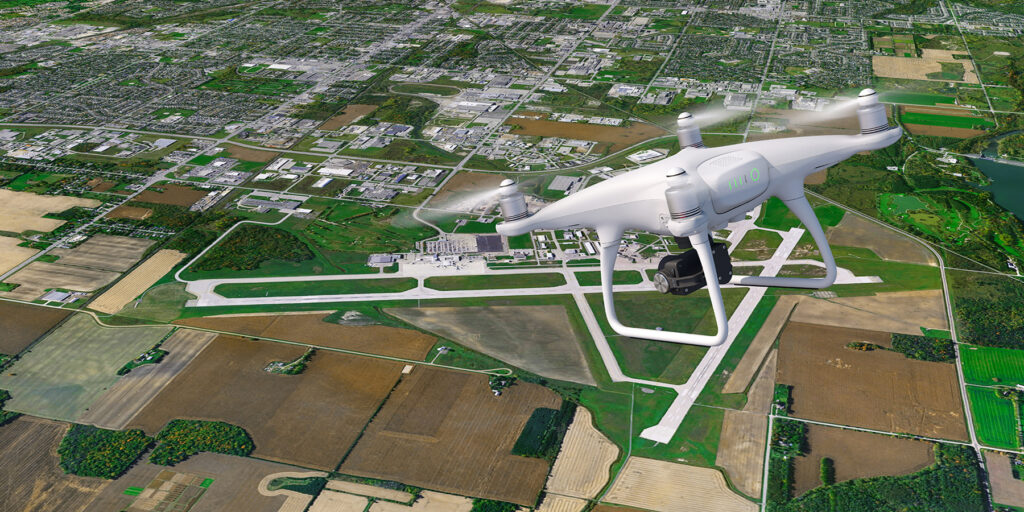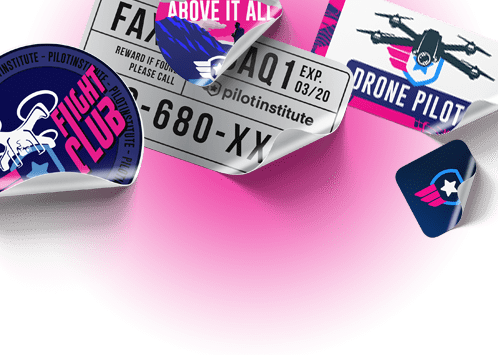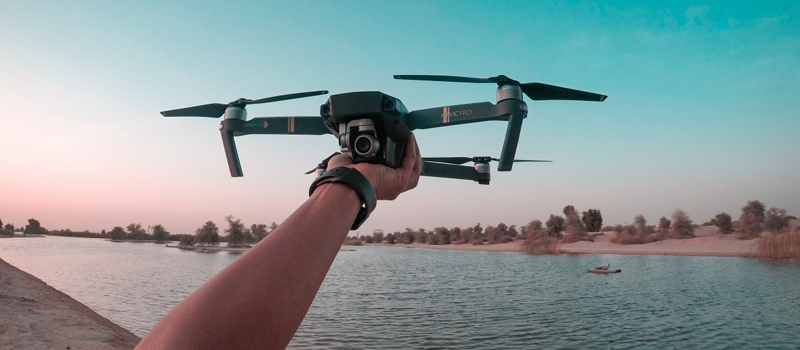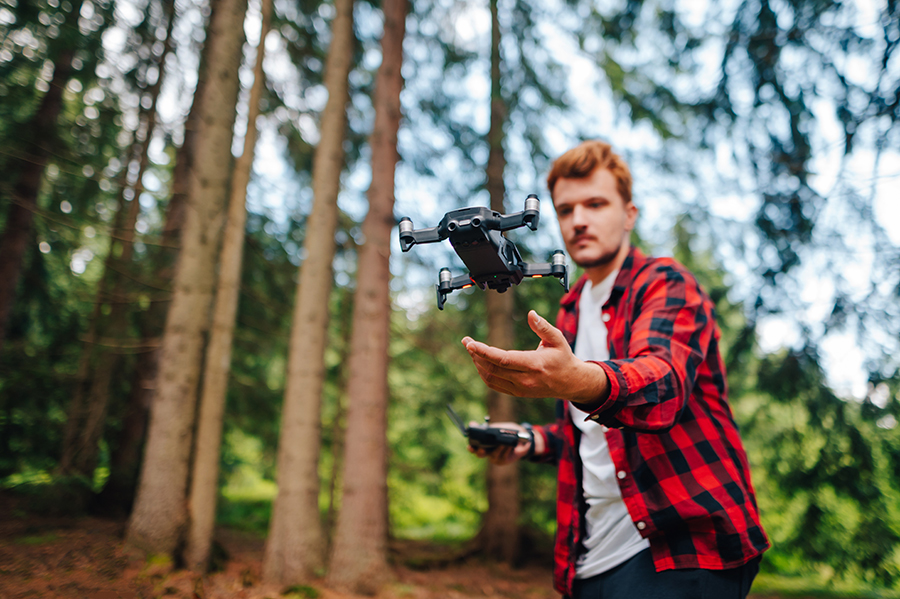-
1. Register your drone with the FAA (if needed)
-
2. Research federal restrictions on drone flight
-
3. Check which airspace classification you’re in
-
4. Do a physical inspection of your drone
-
5. Update the firmware on your drone and controller
-
6. Check your drone’s battery capacity
- Drone News Update
-
7. Set a home location
-
8. Check the weather forecast
-
9. Look for a wide, open space
-
10. Practice at low altitudes
-
Final thoughts
So, you just bought your first drone. Great! You’ll likely spend hundreds of hours flying it in the coming months. However, just like driving a car, you don’t set off on your first drone flight without making a few preparations. An unprepared drone pilot is a dangerous drone pilot – not just to themselves, but to the people and property around them. With that out of the way, here are ten things you need to tick off before taking off on your first drone flight.
1. Register your drone with the FAA (if needed)
The FAA requires all drones that weigh at least 0.55 pounds, whether used recreationally or commercially, to be registered. The registration process is fairly easy. You just need to sign up for an account in the FAA DroneZone portal and register under the appropriate rules. You will have to provide a mailing address, a valid e-mail address, details on the make and model of your drone, and pay the $5 registration fee.
If you are just registering drones for recreational use, you are allowed to register multiple drones under a single serial number. Commercial drone pilots will have to register multiple drones individually, with each on accruing a separate registration payment.
When all that’s done, you should receive a unique serial number via e-mail. You will then need to mark your drone with this serial number in a manner and at a location that makes it clearly visible upon visual inspection. The simplest way to do this is by using a permanent marker or a sticker, but you can also have it engraved on the body of your drone if you want something more permanent.
This measure allows the FAA to identify drones and to trace them back to their owners, should they get into an accident, or be used for more malicious reasons.
2. Research federal restrictions on drone flight
Going back to the car analogy, in the same way that drivers need to follow road rules, drone pilots also have to follow a set of federal regulations. Some rules may differ across recreational and commercial drone pilots, but most of them overlap. Let’s go over the most important ones:
- Do not fly in controlled airspace without the proper authorization (if you’re unsure what controlled airspace is, then check out item number 3)
- Only fly below an altitude of 400 feet when in uncontrolled or Class G airspace
- Only fly your drone within your visual line-of-sight or the line-of-sight of a visual observer who can directly and quickly communicate with you
- Always give way to manned aircraft and avoid flying near them
- Do not fly over crowds, public events, or generally over any person who is not directly involved in your drone operations.
- Do not fly near any emergency situation where your drone may get in the way of emergency responders, law enforcement, firefighters, or search and rescue personnel
- Do not fly your drone if you are physically or mentally unfit, i.e. if you are under the influence of drugs and alcohol
- If you do not have a Part 107 remote pilot certificate, you may fly your drone only recreationally. You cannot fly your drone for profit. This includes taking aerial photos meant to be sold or to be used as advertising materials for any business.
In addition to the federal laws, your city or municipal government may also have their own rules on drone flight. Most of these rules are meant to address common concerns on security and privacy. It’s best to get in touch with local law enforcement just to be sure.

3. Check which airspace classification you’re in
You can think of the national airspace being separated into “zones” depending on the density of air traffic that passes through specific areas. High-traffic areas, such as those near major airports, are considered controlled airspace. Drone flight within controlled airspace is prohibited unless the proper authority has been granted – and even then, only under strict conditions.
There are also areas of restricted airspace, typically near military operations and infrastructure. You may need the proper authorization to fly a drone in such airspace, although some airspace may operate under the “exercise caution” rule.
Every now and then, the FAA may issue a temporary flight restriction (TFR) over areas where there are public gatherings, disaster response operations, or any temporary safety or security issue. Any person or agency can request for a TFR, which the FAA may approve and broadcast.
If you are flying recreationally, the safest place to fly your drone would be in Class G or uncontrolled airspace or in a recreational flyer fixed site (the list of fixed sites can be found here). In the future, you may request for LAANC authorization to fly in controlled airspace, but that’s a topic for another day.
How will you know the airspace classification for your current location? Well, there are several apps for that. B4UFL is one of the most popular and was developed by an FAA-authorized company. Hover is also a pretty comprehensive map that consolidates information on no-fly zones with weather forecasts.
4. Do a physical inspection of your drone
Your drone may still be new, but doing a physical inspection of your drone before you fly is a habit that you should already get into. Start by checking for the proper installation of parts that are removable, including the propellers, gimbal, and battery. Look for any parts that are loose or wiggling, and make sure to have them secured before takeoff.
The next thing to do is to check your drone for any physical damage. The propellers are the most commonly damaged part of the drone because of how thin they are and the amount of punishment they make. Look for any cracks or chipped off sections. It’s best not to gamble with damaged parts and have them replaced right away. For this reason, we like to always have a set of spare propellers on hand.
The last thing to do would be to check the body of the drone for any signs of damage. Remember that the drone is still mostly made of plastic, and although they can take a beating, they are not invulnerable. If your drone is still new and this is your first time taking it out, then any signs of damage can be a cause to claim a warranty on the manufacturer. By doing a check this early, you can avoid liability and having to go through a long argument with your supplier.
5. Update the firmware on your drone and controller
Drone manufacturers release frequent firmware updates for drones and other independent accessories, such as the gimbal and the remote controller. These firmware updates are typically developed to fix some bugs and improve the overall flight experience. Some drone manufacturers may even include new features into these updates, such as additional camera modes and intelligent flight modes.
A more recent trend has drone manufacturers including “geofencing” features into firmware updates. This automatically restricts you from flying in no-fly zones, making sure that you don’t violate any airspace laws. Thankfully, this feature also comes with a convenient way to request authorization by providing your drone’s serial number. These geofencing features have been quite controversial in the past and it remains to be seen if this will be a continuing trend.
You can simply visit your drone manufacturer’s website to check if you have the latest firmware version installed. We highly recommend always keeping your drone’s firmware up to date, so you don’t run into any problems and for you to enjoy any quality of life improvements.
6. Check your drone’s battery capacity
Among the most important specs of a drone is its flight time as a function of its battery capacity. In most drones, this is in the range of 20 to 30 minutes. However, keep in mind that drone manufacturers test the battery capacity of their drones under ideal conditions – low wind, slow movement, and minimal camera use. Under real conditions, you can expect a flight time that is about 5 or 6 minutes lower than the manufacturer’s declared number.
Virtually all drones nowadays have a return-to-home (RTH) function that kicks in whenever the battery hits a low level. The RTH function takes into account how far away the drone is from the home location and calculates how long it will take to fly the way back. This is a nifty safety feature that you should always keep activated.
However, it is still worth the effort to keep tabs on how long you’ve been flying your drone so that you’ll know not to fly too far. The flight time that the RTH function calculates may not be perfectly accurate, as your drone could end up flying against the wind direction and not make it to the home location before the battery expires.
Another advantage of knowing how long you can keep your drone flying on a single battery is that you can estimate how many batteries you’ll have to keep in stock whenever you go out to fly. From our experience, even two batteries are never enough. Determine how long you want to fly your drone and plan accordingly.
7. Set a home location
Related to item number 6, your drone’s RTH function will only work properly if you set the proper home location. The safest location to set would where the drone takes off, so make sure that you get a good GPS signal and that your drone locks in on the location before it flies away.
There are two events in which your drone can automatically activate RTH mode. The first, as we’ve mentioned, is when the battery reaches a low level, and the drone determines that it has just enough juice to make the trip back. The second is when your drone loses radio communication with the controller and doesn’t regain it in a set time.
This can be very important if you intend to fly your drone quite far, or if you’re in an area with lots of radio interference. A drone that can’t communicate with your remote controller is an out of control drone, and the chances of it getting into a crash go way up.
You can also manually activate the RTH mode if you don’t want to pilot the drone back yourself. If you’re doing this, we recommend having the drone fly high enough so that it doesn’t run into any obstacles on the way back.
8. Check the weather forecast
One thing we always tell drone pilots is to respect the weather. After all, if strong winds are enough to cause turbulence to passenger jets, then they could very well crash your drone. Drones also have practically no protection against humidity, and getting one caught in the rain is certainly going to cause havoc on its internal electronics.
Temperature also plays a role in influencing your drone’s performance. Hot days are usually not a problem, but extremely low temperatures can make your drone’s battery stop functioning. To be sure, check your battery’s operating temperature.
Low temperature also means low air pressure, so your drone’s propellers may struggle a bit more than usual in generating lift. You’ll have to take this into account when estimating how long your drone can fly in a single battery cycle, as your propeller engines will inevitably have to work extra hard.
Visibility and cloud cover are two more factors to be considered since you cannot fly your drone beyond the distance where you could still reliably see them.
Our two favorite apps for checking the local weather forecast are Hover and UAV Forecast. These two apps provide hourly temperature, precipitation, and visibility forecasts, so you’ll know when to best start flying. Hover even provides weather forecasts weeks into the future, which can be useful for long-term flight planning.
9. Look for a wide, open space
If this is going to be your first time flying a drone, then you’ll want to give yourself all the handicaps that you could get. Start by looking for a vast field free from large obstacles, bodies of water, or sources of radio interference. You’ll want to steer clear of trees and power lines, as it can only take a wayward wind for you to lose control and have them veer off and crash.
Power lines are a common hazard of drone flight because of the large amount of radio interference they can cause. In a similar vein, communications towers and large industrial equipment must also be avoided. Your remote controller can easily lose its connection with your drone if you fly too close to these structures.
One other thing to keep in mind is to never keep your drone hovering under a canopy of trees. Not only does this diminish your drone’s GPS reception, but drones have a tendency to shoot up to higher altitudes when the RTH mode kicks in. We’ve heard many stories of pilots having their drones hit critical battery levels, climb up in altitude because of RTH, and inadvertently crash into an obstacle. If you must hover, make sure that it’s in a fairly open space free of obstacles in all directions.
10. Practice at low altitudes
Since you’re still starting, the best thing to do for your first flight would be to practice. You’ll need to get comfortable with the controls of your drone, how quickly or sluggishly it reacts to your commands, how it is affected by wind, and how to reorient your sense of direction relative to the drone.
Most drones come with a Beginner mode that is designed for pilots to practice in a much safer environment. In Beginner mode, your drone is restricted to a short range – about 20 or 30 meters. It also limits the drone’s speed and its sensitivity to your controls. For first-time drone pilots, spending several minutes in Beginner mode is a great way to get a feel for how the drone responds.
Even for experienced drone pilots, doing a quick practice at low altitudes is something we recommend including in a pre-flight check. Simply have the drone hover at about 10 feet, check its movement across all directions, and have it rotate both ways. This is a simple test to check if all the propeller motors are working as expected. As with any pre-flight inspection, if you have any doubts about the performance or integrity of your drone, then don’t take off.
Final thoughts
Flying a drone for the first time is very exciting and is certainly an experience that we would like to relive. Compared to a few years ago, drone pilots nowadays are a little more tech-savvy and safety-conscious, so we have all these pre-flight exercises to check if the drone is working as intended and if conditions are optimal for drone flight.
For beginners, we highly recommend all ten of these pre-flight activities. If you’re an experienced drone pilot, then there might still be things that you can learn. Do you have a pre-flight ritual that we haven’t mentioned here? Let us know with your feedback!





